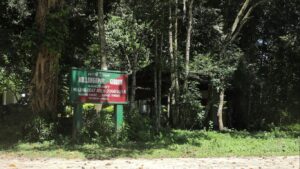Physical Address
23,24,25 & 26, 2nd Floor, Software Technology Park India, Opp: Garware Stadium,MIDC, Chikalthana, Aurangabad, Maharashtra – 431001 India
Physical Address
23,24,25 & 26, 2nd Floor, Software Technology Park India, Opp: Garware Stadium,MIDC, Chikalthana, Aurangabad, Maharashtra – 431001 India

As global temperatures reach record highs and human-induced climate change becomes undeniably tangible, it’s ironic that Assam, an Indian state, faces increasing threats to its National Parks, Wildlife Sanctuaries, and Forest Reserves due to fossil fuel exploration. Recent reports have brought to light that the Indian Environment Ministry has granted approval for oil and gas exploration inside the ecologically sensitive Hoollongapar Gibbon Sanctuary, a region known for being home to the endangered Hoolock Gibbon, India’s only ape. The Sanctuary is located at Mariani under Jorhat district in Assam.
The reports also highlighted that the company, Cairn India (the oil and gas division of Vedanta Ltd), is planning to use 4.5 (approx) hectares of reserved forest land to run its drilling operation inside the eco-sensitive zone of the sanctuary. What is more alarming is the fact that, as the reports further highlighted, even after the Forest Advisory Committee (FAC) of the ministry has deferred its final verdict on the matter, the project has been endorsed by both the state and the regional offices of the ministry.
It has also come to light that the same company has also seeked exploration rights on 1.7155 hectares of forest land in the Namphai reserved forest, part of the Dihing Patkai Elephant Reserve, under Digboi Forest division of Tinsukia district in Assam. The FAC, according to reports, has recommended conditional “in principle” approval.
Baghjan, a lesson forgotten?
It is important to note that these developments are taking place even after past incidents like the Baghjan disaster in Assam showed the risks involved with such fossil fuel exploration in such eco-sensitive areas.
The Baghjan disaster in Assam occurred on May 27, 2020, when a natural gas well operated by Oil India Limited in the Baghjan oil field experienced a blowout, leading to an uncontrollable release of gas. The situation escalated on June 9, when the well caught fire, resulting in extensive damage to the surrounding environment, including the Dibru-Saikhowa National Park and nearby wetlands. The incident caused the displacement of thousands of residents, significant loss of wildlife, and severe ecological damage. Efforts to control the fire and cap the well took several months, highlighting the environmental risks associated with fossil fuel exploration in sensitive areas.
Diversion of protected forest land in Assam
A report by Global Forest Watch had earlier revealed that over 75 percent of India’s total forest cover was destroyed during the 2001-23 period and Assam topped this list among all the states.
There are multiple reports of the government diverting protected forest covers of Assam for various commercial purposes.
In January 2024, the NGT noted allegations that top forest officials in the Assam government had illegally diverted 44 hectares of protected forest land for a Commando Battalion headquarters in Barak Valley.
In April 2024, the Gauhati High Court halted the Assam cabinet’s decision to de-notify Deepor Beel, a wildlife sanctuary and Ramsar site located on the outskirts of Guwahati.
In May 2024, the Supreme Court halted all further work on the proposed greenfield airport at Doloo in Silchar, Assam, citing the lack of an environmental clearance for the project.
Also, in May 2024, the NGT issued a directive about illegal construction activities and encroachments inside the Sonai Rupai Wildlife Sanctuary in Assam’s Sonitpur district.
Climate change in Assam
Between 1990 and 2019, climate change has caused an average annual decrease in rainfall in Assam by over 10mm. This reduction has adversely impacted various sectors, including agriculture, water resources, environment, health, and biodiversity. Additionally, climate change has led to an increase in both maximum and minimum temperatures, resulting in shorter winters and unseasonal rainfall. The maximum temperature has risen by an average of 0.049 degrees Celsius per year, while the minimum temperature has increased by 0.012 degrees Celsius annually.
Gauhati High Court halts govt’s Deepor Beel denotification move, freezes on-site construction
Banner Image: Hoollongapar Gibbon Sanctuary by author
Comments are closed.
Hello climatefactchecks.org webmaster, Your posts are always interesting.